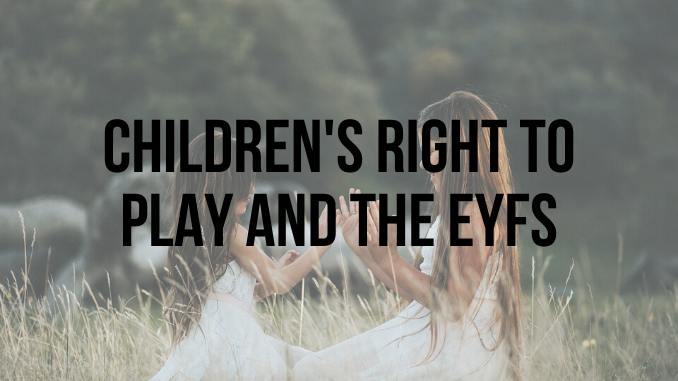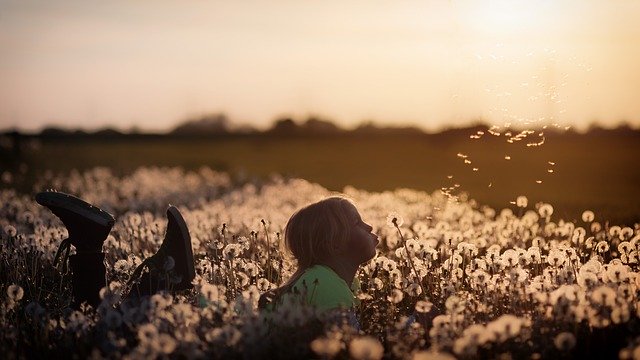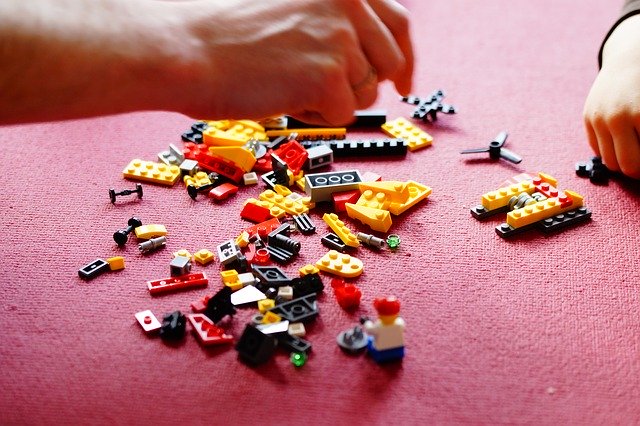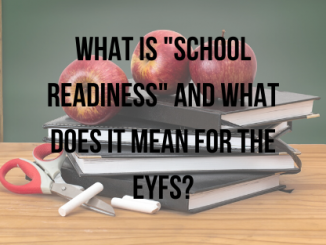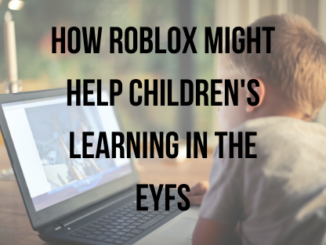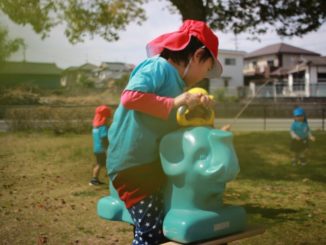Article 31.1 of the United Nations Convention on the Rights of the Child sets out children’s right to play, it reads; “States Parties recognize the right of the child to rest and leisure, to engage in play and recreational activities appropriate to the age of the child and to participate freely in cultural life and the arts” (UNCRC, 1989) but what exactly is ‘play’? and how is it promoted and supported as part of the EYFS?
What is play?
Several key bodies in the UK describe play as “what children and young people do when they follow their own ideas and interests, in their own way, and for their own reasons” yet also state that it is fundamental to children’s learning, and all aspects of their development. (DCMS 2004, DCSF 2008). This emphasis on the crucial nature of play is reflected in the Playwork Principles (2005) which say ‘All children and young people need to play. The impulse to play is innate. Play is a biological, psychological and social necessity, and is fundamental to the healthy development and wellbeing of individuals and communities.’ Here we see enshrined in policy the idea that play is an innate faculty.
Shier (2010) for example regards play as a natural and universal human impulse stating that ‘adults never have to make children play… adults have to let children play’
On what play actually is, a rights-based approach to play should provide some middle-ground by acknowledging play both as a right in itself, and as an important means of achieving other rights. (Davey & Lundy, 2011)
Early Years settings and play
Children now spend increasing amounts of time in Early Years Settings, and these settings have have become a more prominent part of children’s life, thus having a more pronounced influence on children’s development. Therefore, protecting children’s right to play within these settings is imperative.
Early Years settings are interesting in that they straddle the border between care and education, the names by which we call settings demonstrate this tension between the two sectors; on the one hand, we have childminders, nannies and nurseries (emphasising the caring nature of the setting) and on the other preschool, nursery school and Foundation or ‘Early Foundation’ classes (assimilating themselves with ‘school’ and education) This tension between the realm of education and the realm of care has implications for how settings view and implement, children’s right to play.
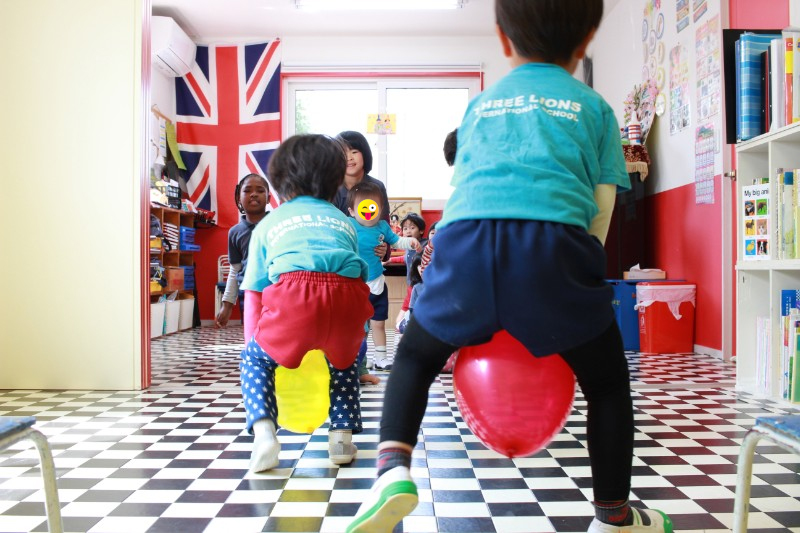
Play as a means of learning
Play is considered crucial to the processes of learning and development (Gleave & Cole-Hamilton, 2012) and effective learning in the early years is often said to be ‘learning through play’, or ‘playful learning’, which is central to quality early childhood pedagogy and education. (UNICEF, 2018)
The notion that playing takes a central role in developing cognitive skills is built upon the work of both Piaget and Vygotsky, who both emphasised the key role of play in children’s development (Zigler and Bishop-Josef 2009; Vygotsky, 1976)).
On the whole, Early Years Policy does seem to recognise the instrumental value of play; For example, in UK settings, the Early Years Foundation Stage (EYFS) names ‘playing and exploring’ as a characteristic of effective learning.
Yet, even in developed countries such as the UK, US, Canada and Australia, despite government policy supporting at least the instrumental value of play, delivering this within settings remains a challenge.
Challenges to children’s right to play
Discourses of Early childhood pedagogy in developed nations advocate for a play-based approach to learning, growth and development. However, play is a contested concept and educators’ understandings can vary. Whilst some maintain that play is varied and flexible and there is no ‘right’ or ‘wrong’ way to play (Gleave & Cole-Hamilton, 2012) this is not always exemplified in practice. Many settings would claim to be “Child-led” but in practice it is staff that control much of the behaviour, environment and resources, including time.
Despite finding support for outdoor play within the EYFS Statutory Framework (DfE, 2017) and indeed in the policy of other developed nations (DEEWR, 2009) when studied, the pervading culture of fear (Furedi, 2002)) in which children are developing, means that many school leaders cite fear of litigation as a barrier to allowing significant access to outdoor spaces (Gill, 2007) Indeed, a study by Munroe and McLellan-Mansell (2013), found that almost all educators named fears about safety as a barrier to outdoor play.
Time-constraints, on time spent outdoors, are another example of pressure upon the right to play within Early Years settings (Elkind, 2008; Blatchford et al., 2002).
The global drive to expand and integrate early education services into education systems means that it can be tempting to extend primary education ideas and methods of teaching and learning down into the pre-primary level, despite this not being in children’s best interests (UNICEF, 2018) along with this expansion of primary teaching often comes the loss of free, self-directed play, which is replaced with structured, educational activities (Hofferth and Sandberg 2000).
Adult controlled?
Where play is allowed it is dependent upon adults who control the environment, the resources available, time allowed for play and also the type of play which is allowed, moving it away from the definition of ‘what children do without adult interference’ or “what children and young people do when they follow their own ideas and interests, in their own way, for their own reasons”
For example, the UK developed a zero-tolerance approach to playing with toy guns, discouraging all forms of it within early years settings (Holland, 2000) out of fear that mere exposure to the use of these play weapons encourages real aggression. (Bandura & Jeffery, 1973).
Another example of restrictions upon the way children play in Early Years settings is the concept of ‘risky play’. Modern society has become a risk society, increasingly occupied with preventing and managing the risks it has produced (Beck, 2006) the culture of fear and risk aversion severely restricts children’s independence and is leading to increasing institutionalisation of their lives (Thomas and Hocking 2003, Veitch et al. 2006). However, in seeking to avoid risk we limit freedom to play and, as a result, limit growth and development (Bundy et al, 2009)
The power dynamic between adults and children in settings is interesting to note. When carrying out an intervention project, Tyrie et al (2019) found that one of the main barriers to play was constraints imposed by school staff; These included fears over the weather, value judgements about the types of play children chose and insisting upon imposing rules or structure to play sessions.
In short, children’s right to play faces many barriers within the EYFS, including instrumentalization of play, time constraints, educator bias on appropriate types of play, and health and safety concerns. Rising above these constraints is difficult, but should be part of the aim for best practice in the Early Years.
References:
Bandura A, Jeffery RW (1973) Role of symbolic coding and rehearsal processes in observational learning. Journal of Personality and Social Psychology 26: 122–130.
Beck, U. (2006) Living in the world risk society. Economy and Society 35 (3) 329-345
Bundy, A.C., Luckett, T., Tranter, P.J., Naughton, G.A. Wyver, S., Spies, G and Ragen, J. (2009) The risk is that there is ‘No Risk’ a simple innovative intervention to increase children’s activity levels, international Journal of Food Science and Technology 17:33-45
Blatchford, P, Pellegrini, T, Baines, E and Kentaro, K (2002) Playground Games: their social context in elementary/junior school. Final report to the Spencer Foundation 2002. Available online at: http://www.breaktime.org.uk/SpencerFinalReport02.pdf
Davey,C. and Lundy, L. (2011) Towards Greater Recognition of the Right to Play: An Analysis of Article 31 of the UNCR, Children & Society 25, pp. 3–14
Department for Children, Schools and Families (2008). Play England’s Charter for play
Department of Education, Employment and Workplace Relations (DEEWR). (2009). Belonging, Being & Becoming: The Early Years Learning Framework for Australia. Canberra, ACT: Commonwealth of Australia.
Elkind, D (2008) ‘ The power of play: Learning what comes naturally ’, American Journal of Play, 1, 1, Summer, 1–6.
Furedi, F. 2002. Culture of Fear: Risk Taking and the Morality of Low Expectation. 2nd ed. London: Continuum.
Gleave, J. & Cole-Hamilton, I. (2012) A literature review on the effects of a lack of play on children’s lives accessed via www.playengland.org.uk
Hofferth, S L and Sandberg, J F (2000) Changes in American Children’s Time: 1981–1997. Available online from: http://ceel.psc.isr.umich.edu/pubs/papers/ceel013–00.pdf
Holland P (2000) Take the toys from the boys? An examination of the Genesis of policy and the appropriateness of adult perspectives in the area of war, weapon and superhero play. Citizenship, Social and Economics Education 4: 92 –108.
Munroe, E., & McLellan-Mansell, A. (2013). Outdoor play experiences for young first nations children in Nova Scotia: Examining the barriers and considering some solutions. Canadian Children, 38(2), 25–33.
Playwork Principles Scrutiny Group (2005) Playwork Principles . Play Wales, Cardiff. Available online at: http://www.skillsactive.com/playwork/principles
Shier, H (2010) IPA Global Consultations on Children’s Right to Play: Summary report. Available online at: http://article31.ipaworld.org/wp-content/uploads/2010/10/ GlobalReportSUMMARY-201010.pdf
Thomas, G. and Hocking, G. (2003). Other People’s Children. London: Demos.
Tyrie,J. Sarwar, S., Dumitrscu, S., Mannello, M., Haughton, C., Ellis, C. & Connolly, M. (2019) Power, rights and play: control of play in school grounds, an action research project from Wales, Education 3-13, 47:6, 627-636
UNICEF (2018) Learning through play: Strengthening Learning through play in Early Childhood Education programmes, UNICEF Education Section, Programme Division)
Veitch, J., Bagley, S., Ball, K. and Salmon, J. (2006). Where do children usually play? A qualitative study of parents’ perceptions of influences on children’s active free-play. Health and Place 12: 383–393.
Vygotsky, L. S. (1976). Play and its role in mental development of the child. In J. Bruner, A. Jolly & K. Sylva (Eds.), Play: Its role in development and evolution (pp. 537–554). New York, NY: Basic books
Vygotsky, L. S. (1978). Mind in Society: the Development of Higher Psychological Processes. Cambridge, MA: Harvard University Press.
Zigler, E and Bishop-Josef, S J (2009) ‘Play under siege: A historical perspective’, Zero to Three, 30, 1, 4–11

